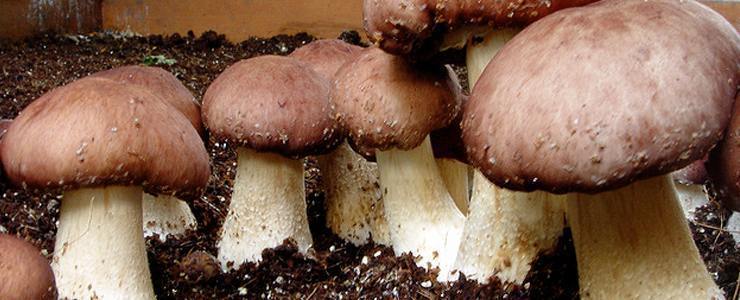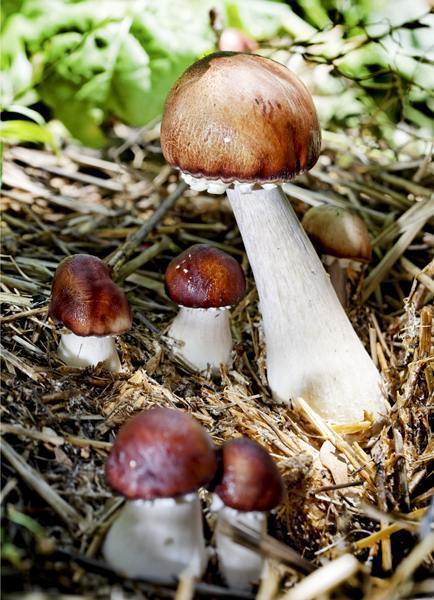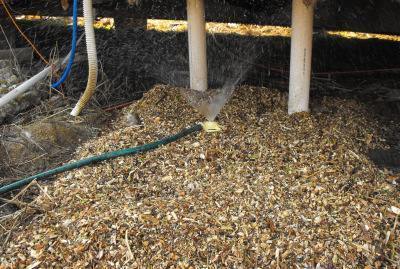Wine cap mushrooms, information about cultivation technology

Wine cap mushroom (Stropharia rugosoannulata) was first cultivated in 1922 in Germany, in 1930 in Czechoslovakia, later in Japan, and quite recently in France.
Botanical particularities
The mushroom’s cap is robust, vigorous, the color being different depending on the variety and temperature of the environment, from yellow to brown, with different shades of red.
The stem is quite long (8-30 cm), greyish-white, with a small diameter of 1-3 cm. The ring is fibrous, wavy on the upper side, and crenulate on the lower side. It is a saprophytic cellulosic species, growing naturally near deposits of deciduous or other material with a high cellulose content.
Cultivation
Two methods of culture are known:
Open-air or semi-sheltered cultivation (in warm, wind-sheltered locations, using trees, other plant species, or protection foils).
Directed cultivation, which is carried out in cellars, nurseries, or shelters (polyhouses or foil tunnels).
Wine cap mushrooms can be cultivated in association with white mushrooms and shaggy mane mushrooms, requiring the same microclimate conditions. For incubation, the temperature is 20 °C, and for fruiting, 10-20 °C. The mycelium can withstand negative temperatures down to -10 °C and positive temperatures up to 30-32 °C.
Culture technology
It is relatively simple due to the fact that materials can be used as a nutrient substrate that does not require prior preparation or composting. Wheat straw or flax stalks are used, without adding chemical or organic fertilizers so that the mycelium can grow slowly.
For 3-5 days the straw is moistened in the platform by sprinkling or 1-2 days by submerging in the basin.
20 kg of dry straw is needed for 1 m² of surface area. The dry straw is watered until saturation, laying it on the platform in successive layers of 40 cm. The layers’ thickness should be reduced by pressing to half.
The moisture in the platform is homogenized after 2-3 days by repositioning the straw. The humidity is increased if necessary and after 2-3 days the straw can be transported to the cultivation site.
Since calcium has an inhibitory effect on the mycelium, do not add gypsum or calcium carbonate.
Nutrient substrate
The substrate is laid in row beds (in a flat layer), in cellars (in a flat layer or in polythene bags), in polyhouses or foil tunnels (in wooden or plastic sheets, overlapped).
The mycelium is produced and delivered in the form of straw rolls, for an area of 1-1.5 m2, 500-600 g are needed. The rolls are broken into pieces the size of a walnut. The inoculation is done in open nests by hand, 15 cm apart and 4-5 cm deep, thus achieving a density of 40 nests per m2.
The complete invasion of the nutritive substrate by the mycelium takes place in 3-9 weeks, at which time it is necessary to cover it.
The cover mixture is prepared according to one of the following recipes: 70-80% black peat + 20-30% sand or 70% mix soil + 30% sand. The covering mixture must not contain calcium or calcium carbonate and the pH must be between 5.7-6.
Harvesting
For hotbeds cultivation, harvesting begins 12 weeks after inoculation and 4-5 weeks after cover. Harvesting is done by twisting the mushroom to full maturity. The wine cap mushrooms yield is 12-14 kg / m2, both in the cellars and in the hotbeds. The production comes from both the autumn and spring period (March-April).

















































































































































































































































































































































































































































